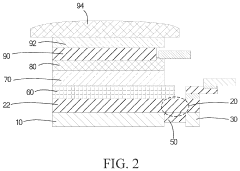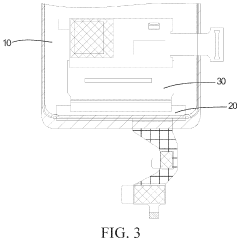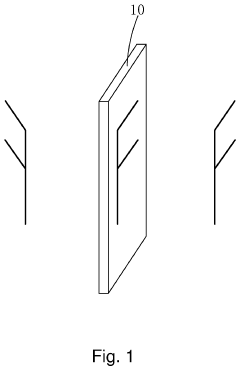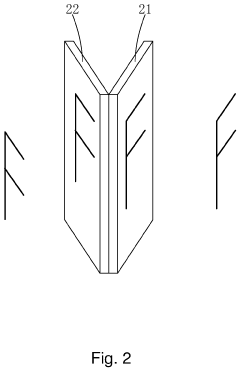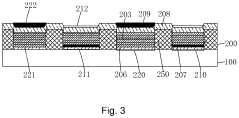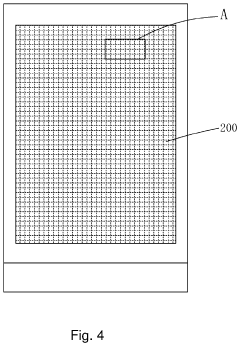How AMOLED enhances environmental monitoring systems?
JUL 17, 20259 MIN READ
Generate Your Research Report Instantly with AI Agent
Patsnap Eureka helps you evaluate technical feasibility & market potential.
AMOLED in Environmental Monitoring: Background and Objectives
Active-Matrix Organic Light-Emitting Diode (AMOLED) technology has emerged as a revolutionary advancement in display systems, offering significant potential for enhancing environmental monitoring capabilities. The evolution of AMOLED technology can be traced back to the late 1980s, with the discovery of electroluminescent organic materials. Since then, continuous research and development have led to remarkable improvements in display quality, energy efficiency, and durability.
In the context of environmental monitoring, AMOLED displays present a unique set of advantages that align well with the demanding requirements of field-based and remote sensing applications. The technology's ability to produce vibrant colors, high contrast ratios, and wide viewing angles makes it particularly suitable for displaying complex environmental data in various lighting conditions. This is crucial for researchers and field technicians who often work in challenging outdoor environments.
The primary objective of integrating AMOLED technology into environmental monitoring systems is to enhance the accuracy, efficiency, and reliability of data collection and visualization processes. By leveraging the superior display characteristics of AMOLED, environmental scientists and technicians can more effectively interpret real-time data, leading to faster and more informed decision-making in critical situations such as natural disasters, pollution events, or climate change studies.
Another key goal is to improve the energy efficiency of portable environmental monitoring devices. AMOLED displays consume significantly less power compared to traditional LCD screens, especially when displaying darker content. This feature is particularly beneficial for battery-powered devices used in remote locations, enabling longer operational times and reducing the need for frequent recharging or battery replacements.
Furthermore, the integration of AMOLED technology aims to expand the capabilities of environmental monitoring systems by enabling the development of flexible and even transparent displays. These innovative form factors could revolutionize how environmental data is collected and presented, allowing for seamless integration of displays into various surfaces and equipment used in field research.
As we look towards the future, the continued advancement of AMOLED technology is expected to play a crucial role in addressing the growing complexities of environmental monitoring. The technology's potential to provide high-quality, energy-efficient displays that can withstand harsh environmental conditions positions it as a key enabler for next-generation monitoring systems. By enhancing data visualization and device portability, AMOLED technology is set to contribute significantly to our understanding and management of environmental challenges in the coming years.
In the context of environmental monitoring, AMOLED displays present a unique set of advantages that align well with the demanding requirements of field-based and remote sensing applications. The technology's ability to produce vibrant colors, high contrast ratios, and wide viewing angles makes it particularly suitable for displaying complex environmental data in various lighting conditions. This is crucial for researchers and field technicians who often work in challenging outdoor environments.
The primary objective of integrating AMOLED technology into environmental monitoring systems is to enhance the accuracy, efficiency, and reliability of data collection and visualization processes. By leveraging the superior display characteristics of AMOLED, environmental scientists and technicians can more effectively interpret real-time data, leading to faster and more informed decision-making in critical situations such as natural disasters, pollution events, or climate change studies.
Another key goal is to improve the energy efficiency of portable environmental monitoring devices. AMOLED displays consume significantly less power compared to traditional LCD screens, especially when displaying darker content. This feature is particularly beneficial for battery-powered devices used in remote locations, enabling longer operational times and reducing the need for frequent recharging or battery replacements.
Furthermore, the integration of AMOLED technology aims to expand the capabilities of environmental monitoring systems by enabling the development of flexible and even transparent displays. These innovative form factors could revolutionize how environmental data is collected and presented, allowing for seamless integration of displays into various surfaces and equipment used in field research.
As we look towards the future, the continued advancement of AMOLED technology is expected to play a crucial role in addressing the growing complexities of environmental monitoring. The technology's potential to provide high-quality, energy-efficient displays that can withstand harsh environmental conditions positions it as a key enabler for next-generation monitoring systems. By enhancing data visualization and device portability, AMOLED technology is set to contribute significantly to our understanding and management of environmental challenges in the coming years.
Market Analysis for AMOLED-based Environmental Sensors
The AMOLED-based environmental sensor market is experiencing significant growth, driven by the increasing demand for advanced monitoring systems across various industries. The global market for these sensors is projected to expand at a robust rate over the next five years, with a particular focus on applications in air quality monitoring, water quality assessment, and industrial emissions control.
One of the key factors fueling market growth is the rising awareness of environmental issues and the subsequent need for more accurate and real-time monitoring solutions. Governments worldwide are implementing stricter regulations on environmental protection, creating a favorable landscape for AMOLED-based sensor adoption. Industries such as manufacturing, agriculture, and smart cities are increasingly integrating these sensors into their operations to ensure compliance with environmental standards and optimize resource management.
The market for AMOLED-based environmental sensors is segmented by application, end-user industry, and geography. In terms of application, air quality monitoring currently holds the largest market share, followed by water quality assessment and soil contamination detection. The industrial sector remains the primary end-user, with significant adoption in manufacturing plants, chemical facilities, and power generation units. However, the residential and commercial sectors are expected to witness the highest growth rate in the coming years, driven by the increasing integration of environmental sensors in smart home systems and office buildings.
Geographically, North America and Europe are the leading markets for AMOLED-based environmental sensors, owing to stringent environmental regulations and high technological adoption rates. However, the Asia-Pacific region is anticipated to emerge as the fastest-growing market, propelled by rapid industrialization, urbanization, and increasing environmental concerns in countries like China and India.
The competitive landscape of the AMOLED-based environmental sensor market is characterized by the presence of both established players and innovative startups. Key market players are focusing on research and development activities to enhance sensor capabilities, improve energy efficiency, and reduce production costs. Strategic partnerships and collaborations between sensor manufacturers and environmental monitoring solution providers are becoming increasingly common, aiming to offer integrated and comprehensive monitoring systems.
Despite the positive outlook, the market faces certain challenges. The high initial cost of AMOLED-based sensors compared to traditional sensing technologies remains a barrier to widespread adoption, particularly in price-sensitive markets. Additionally, the complexity of data interpretation and the need for specialized expertise in handling these advanced sensors pose challenges for some end-users. However, ongoing technological advancements and the development of user-friendly interfaces are expected to address these issues in the near future.
One of the key factors fueling market growth is the rising awareness of environmental issues and the subsequent need for more accurate and real-time monitoring solutions. Governments worldwide are implementing stricter regulations on environmental protection, creating a favorable landscape for AMOLED-based sensor adoption. Industries such as manufacturing, agriculture, and smart cities are increasingly integrating these sensors into their operations to ensure compliance with environmental standards and optimize resource management.
The market for AMOLED-based environmental sensors is segmented by application, end-user industry, and geography. In terms of application, air quality monitoring currently holds the largest market share, followed by water quality assessment and soil contamination detection. The industrial sector remains the primary end-user, with significant adoption in manufacturing plants, chemical facilities, and power generation units. However, the residential and commercial sectors are expected to witness the highest growth rate in the coming years, driven by the increasing integration of environmental sensors in smart home systems and office buildings.
Geographically, North America and Europe are the leading markets for AMOLED-based environmental sensors, owing to stringent environmental regulations and high technological adoption rates. However, the Asia-Pacific region is anticipated to emerge as the fastest-growing market, propelled by rapid industrialization, urbanization, and increasing environmental concerns in countries like China and India.
The competitive landscape of the AMOLED-based environmental sensor market is characterized by the presence of both established players and innovative startups. Key market players are focusing on research and development activities to enhance sensor capabilities, improve energy efficiency, and reduce production costs. Strategic partnerships and collaborations between sensor manufacturers and environmental monitoring solution providers are becoming increasingly common, aiming to offer integrated and comprehensive monitoring systems.
Despite the positive outlook, the market faces certain challenges. The high initial cost of AMOLED-based sensors compared to traditional sensing technologies remains a barrier to widespread adoption, particularly in price-sensitive markets. Additionally, the complexity of data interpretation and the need for specialized expertise in handling these advanced sensors pose challenges for some end-users. However, ongoing technological advancements and the development of user-friendly interfaces are expected to address these issues in the near future.
Current Challenges in AMOLED Environmental Monitoring
The integration of AMOLED technology into environmental monitoring systems has brought significant advancements, yet it also faces several challenges that need to be addressed for optimal performance and widespread adoption. One of the primary concerns is the power consumption of AMOLED displays in continuous monitoring applications. While AMOLED screens are known for their energy efficiency, the constant operation required in environmental monitoring can still lead to substantial battery drain, limiting the deployment duration of portable devices.
Another challenge lies in the durability and longevity of AMOLED displays when exposed to harsh environmental conditions. Environmental monitoring often occurs in extreme temperatures, high humidity, or corrosive atmospheres, which can potentially degrade the organic materials used in AMOLED screens. This vulnerability raises concerns about the long-term reliability of these displays in outdoor monitoring stations or industrial settings.
The cost factor also presents a significant hurdle in the widespread adoption of AMOLED technology in environmental monitoring systems. High-quality AMOLED displays remain relatively expensive compared to traditional LCD screens, which can impact the overall cost of monitoring equipment. This price premium may limit the accessibility of AMOLED-enhanced systems, particularly for smaller organizations or in large-scale deployment scenarios.
Color accuracy and calibration pose another challenge, especially in applications requiring precise color representation of environmental data. While AMOLED displays offer vibrant colors and high contrast ratios, maintaining consistent color accuracy across different lighting conditions and over extended periods can be difficult. This is particularly crucial in monitoring applications where color changes may indicate critical environmental shifts.
The issue of burn-in or image retention is also a concern in AMOLED displays used for environmental monitoring. Static elements in monitoring interfaces, such as graphs or status indicators, may cause permanent ghosting effects over time, potentially compromising the display's clarity and the accuracy of visual data representation.
Lastly, the integration of touch functionality with AMOLED displays in environmental monitoring systems presents its own set of challenges. Ensuring reliable touch response in various environmental conditions, such as rain or when wearing protective gloves, is crucial for the usability of these systems in field applications. Balancing touch sensitivity with durability and environmental resistance adds another layer of complexity to the design and implementation of AMOLED-based monitoring devices.
Another challenge lies in the durability and longevity of AMOLED displays when exposed to harsh environmental conditions. Environmental monitoring often occurs in extreme temperatures, high humidity, or corrosive atmospheres, which can potentially degrade the organic materials used in AMOLED screens. This vulnerability raises concerns about the long-term reliability of these displays in outdoor monitoring stations or industrial settings.
The cost factor also presents a significant hurdle in the widespread adoption of AMOLED technology in environmental monitoring systems. High-quality AMOLED displays remain relatively expensive compared to traditional LCD screens, which can impact the overall cost of monitoring equipment. This price premium may limit the accessibility of AMOLED-enhanced systems, particularly for smaller organizations or in large-scale deployment scenarios.
Color accuracy and calibration pose another challenge, especially in applications requiring precise color representation of environmental data. While AMOLED displays offer vibrant colors and high contrast ratios, maintaining consistent color accuracy across different lighting conditions and over extended periods can be difficult. This is particularly crucial in monitoring applications where color changes may indicate critical environmental shifts.
The issue of burn-in or image retention is also a concern in AMOLED displays used for environmental monitoring. Static elements in monitoring interfaces, such as graphs or status indicators, may cause permanent ghosting effects over time, potentially compromising the display's clarity and the accuracy of visual data representation.
Lastly, the integration of touch functionality with AMOLED displays in environmental monitoring systems presents its own set of challenges. Ensuring reliable touch response in various environmental conditions, such as rain or when wearing protective gloves, is crucial for the usability of these systems in field applications. Balancing touch sensitivity with durability and environmental resistance adds another layer of complexity to the design and implementation of AMOLED-based monitoring devices.
Existing AMOLED Solutions for Environmental Monitoring
01 Pixel circuit optimization
Improving AMOLED display performance through enhanced pixel circuit designs. This includes optimizing transistor configurations, implementing compensation schemes for voltage drops, and developing more efficient driving methods to improve image quality and reduce power consumption.- Pixel circuit optimization for AMOLED displays: Improving pixel circuits in AMOLED displays to enhance overall performance. This includes techniques for better current control, reduced power consumption, and improved brightness uniformity across the display. These optimizations can lead to more efficient and higher quality AMOLED screens.
- OLED material and structure enhancements: Advancements in OLED materials and structural designs to improve display performance. This includes developing new organic compounds, optimizing layer structures, and enhancing light emission efficiency. These improvements can result in brighter, more color-accurate, and longer-lasting AMOLED displays.
- Driving and compensation techniques: Implementation of advanced driving schemes and compensation algorithms to address issues such as non-uniformity and aging in AMOLED displays. These techniques can help maintain consistent image quality over time and improve overall display performance.
- Integration of additional functionalities: Incorporating additional features into AMOLED displays, such as touch sensing, fingerprint recognition, and under-display cameras. These integrations can enhance the overall functionality and user experience of devices using AMOLED technology.
- Power efficiency and management: Developing techniques to improve power efficiency and management in AMOLED displays. This includes optimizing power consumption during different display modes, implementing adaptive brightness control, and enhancing overall energy efficiency of the display system.
02 OLED material enhancements
Developing and implementing advanced OLED materials to enhance display performance. This involves creating new organic compounds, improving electron transport layers, and optimizing the structure of light-emitting layers to increase efficiency, color accuracy, and longevity of AMOLED displays.Expand Specific Solutions03 Display driving techniques
Implementing innovative display driving techniques to enhance AMOLED performance. This includes developing advanced timing controllers, implementing dynamic refresh rates, and creating more sophisticated gamma correction methods to improve image quality and reduce power consumption.Expand Specific Solutions04 Touch integration and sensing
Integrating touch functionality and advanced sensing capabilities into AMOLED displays. This involves developing in-cell touch solutions, implementing force-sensing technology, and creating more accurate fingerprint recognition systems directly within the display.Expand Specific Solutions05 Power efficiency improvements
Enhancing the power efficiency of AMOLED displays through various techniques. This includes implementing adaptive brightness control, developing more efficient power management circuits, and optimizing the display's overall power consumption to extend battery life in mobile devices.Expand Specific Solutions
Key Players in AMOLED and Environmental Monitoring
The AMOLED technology for environmental monitoring systems is in a growth phase, with increasing market size and advancing technological maturity. Key players like BOE Technology, TCL China Star Optoelectronics, and Innolux Corp are driving innovation in this field. The market is experiencing rapid expansion due to the growing demand for high-performance displays in environmental monitoring applications. Companies such as Everdisplay Optronics and Tianma Microelectronics are contributing to the technological advancements, focusing on improving AMOLED's energy efficiency and durability for outdoor use. As the technology matures, we can expect more specialized applications and enhanced integration with environmental sensors, leading to more sophisticated and accurate monitoring systems.
BOE Technology Group Co., Ltd.
Technical Solution: BOE has developed AMOLED displays with enhanced color accuracy and brightness for environmental monitoring systems. Their technology incorporates high-resolution sensors that can detect minute changes in air quality, temperature, and humidity. The AMOLED screens provide vivid, real-time data visualization, allowing for more intuitive interpretation of environmental data. BOE's displays feature low power consumption and high contrast ratios, making them suitable for outdoor use in various lighting conditions[1][3]. The company has also integrated touch functionality, enabling interactive data exploration and system control directly on the display.
Strengths: Superior color reproduction and brightness for clear data visualization. Low power consumption ideal for portable monitoring devices. Weaknesses: Higher production costs compared to traditional LCD displays. Potential for burn-in over extended periods of continuous use.
Shanghai Tianma Microelectronics Co., Ltd.
Technical Solution: Tianma has developed AMOLED displays optimized for environmental monitoring systems with a focus on energy efficiency and long-term reliability. Their displays utilize low-temperature polysilicon (LTPS) backplanes, which offer higher electron mobility and lower power consumption compared to traditional amorphous silicon displays[6]. Tianma's AMOLED panels feature high contrast ratios and wide color gamuts, enabling accurate representation of environmental data across various spectrums. The company has also implemented advanced thin-film encapsulation techniques to protect the organic materials from moisture and oxygen, extending the lifespan of displays in harsh environmental conditions.
Strengths: High energy efficiency suitable for battery-powered monitoring devices. Enhanced durability for deployment in challenging environments. Weaknesses: Limited production capacity compared to larger competitors. Higher costs associated with specialized encapsulation techniques.
Core AMOLED Innovations for Environmental Sensing
Active matrix organic light emitting diode panel
PatentInactiveUS20200185645A1
Innovation
- An AMOLED panel design featuring a hydrogel layer coated between two backing plates at the bent portion, which is then solidified with ultraviolet light, providing structural strength and toughness to the fillet formed when the panel is folded, thereby preventing deformation and breakage.
Amoled double-side display
PatentActiveUS20200219957A1
Innovation
- An AMOLED double-sided display design featuring a substrate with alternating top-emitting and bottom-emitting OLED units, where the anode of top-emitting units is thicker and reflective, and the cathode of bottom-emitting units is thicker and light-transmissive, allowing for single IC control and eliminating mirrored images.
Energy Efficiency and Sustainability Aspects
AMOLED technology significantly enhances the energy efficiency and sustainability aspects of environmental monitoring systems. The inherent characteristics of AMOLED displays contribute to reduced power consumption, which is crucial for long-term deployment of monitoring devices in remote or challenging environments.
AMOLED screens offer superior energy efficiency compared to traditional LCD displays. They only illuminate the necessary pixels, resulting in lower overall power usage, especially when displaying darker content. This feature is particularly beneficial for environmental monitoring systems that often operate in low-light conditions or require constant display of data.
The reduced power consumption of AMOLED displays extends the battery life of monitoring devices, allowing for longer operational periods between charges or battery replacements. This increased longevity is essential for environmental monitoring systems deployed in hard-to-reach locations or those requiring continuous operation over extended periods.
AMOLED technology also contributes to the sustainability of environmental monitoring systems through its durability and longevity. These displays are less prone to degradation over time compared to other display technologies, reducing the need for frequent replacements and minimizing electronic waste.
The improved visibility of AMOLED displays in various lighting conditions enhances the usability of environmental monitoring systems. This feature allows for more accurate data reading and interpretation, potentially reducing errors and improving the overall efficiency of monitoring processes.
Furthermore, the thin and flexible nature of AMOLED displays enables the design of more compact and lightweight monitoring devices. This characteristic not only reduces material usage but also facilitates easier transportation and installation of monitoring equipment in diverse environmental settings.
The integration of AMOLED technology in environmental monitoring systems aligns with broader sustainability goals by promoting energy-efficient and long-lasting solutions. As environmental monitoring becomes increasingly crucial in addressing global challenges, the adoption of AMOLED displays represents a step towards more sustainable and effective monitoring practices.
AMOLED screens offer superior energy efficiency compared to traditional LCD displays. They only illuminate the necessary pixels, resulting in lower overall power usage, especially when displaying darker content. This feature is particularly beneficial for environmental monitoring systems that often operate in low-light conditions or require constant display of data.
The reduced power consumption of AMOLED displays extends the battery life of monitoring devices, allowing for longer operational periods between charges or battery replacements. This increased longevity is essential for environmental monitoring systems deployed in hard-to-reach locations or those requiring continuous operation over extended periods.
AMOLED technology also contributes to the sustainability of environmental monitoring systems through its durability and longevity. These displays are less prone to degradation over time compared to other display technologies, reducing the need for frequent replacements and minimizing electronic waste.
The improved visibility of AMOLED displays in various lighting conditions enhances the usability of environmental monitoring systems. This feature allows for more accurate data reading and interpretation, potentially reducing errors and improving the overall efficiency of monitoring processes.
Furthermore, the thin and flexible nature of AMOLED displays enables the design of more compact and lightweight monitoring devices. This characteristic not only reduces material usage but also facilitates easier transportation and installation of monitoring equipment in diverse environmental settings.
The integration of AMOLED technology in environmental monitoring systems aligns with broader sustainability goals by promoting energy-efficient and long-lasting solutions. As environmental monitoring becomes increasingly crucial in addressing global challenges, the adoption of AMOLED displays represents a step towards more sustainable and effective monitoring practices.
Data Visualization and User Interface Advancements
AMOLED technology has revolutionized data visualization and user interface advancements in environmental monitoring systems. The high contrast ratio and deep blacks of AMOLED displays significantly enhance the visibility of environmental data, especially in outdoor settings where traditional LCD screens may struggle with glare and readability.
The superior color reproduction capabilities of AMOLED screens allow for more nuanced and accurate representation of environmental data. This is particularly crucial when displaying complex datasets such as temperature gradients, pollution levels, or ecosystem health indicators. The vivid colors and wide color gamut enable researchers and field workers to discern subtle variations in data that might otherwise be overlooked.
AMOLED's ability to selectively illuminate individual pixels contributes to improved power efficiency in environmental monitoring devices. This feature is especially valuable for portable and remote sensing equipment, where battery life is a critical factor. By only lighting up necessary pixels, AMOLED displays can extend the operational time of monitoring systems in the field.
The flexibility of AMOLED panels opens up new possibilities for user interface design in environmental monitoring tools. Curved or even foldable displays can be integrated into wearable devices or compact field equipment, allowing for more ergonomic and user-friendly interfaces. This adaptability enhances the usability of monitoring systems in diverse environmental conditions.
AMOLED's fast refresh rates and low response times enable smooth animations and real-time data updates. This is particularly beneficial for displaying dynamic environmental phenomena such as weather patterns, wildlife movements, or rapid changes in air quality. The fluid visual experience aids in the interpretation of time-sensitive environmental data.
The thin profile and lightweight nature of AMOLED displays contribute to the overall portability of environmental monitoring devices. This allows for the development of more compact and mobile monitoring solutions, enabling researchers to access and analyze data in remote or challenging locations with greater ease.
AMOLED technology also supports advanced touch interfaces, facilitating more intuitive interaction with environmental data. Multi-touch capabilities and pressure-sensitive inputs enable users to navigate complex datasets, zoom into specific areas of interest, and manipulate 3D environmental models with greater precision and control.
The superior color reproduction capabilities of AMOLED screens allow for more nuanced and accurate representation of environmental data. This is particularly crucial when displaying complex datasets such as temperature gradients, pollution levels, or ecosystem health indicators. The vivid colors and wide color gamut enable researchers and field workers to discern subtle variations in data that might otherwise be overlooked.
AMOLED's ability to selectively illuminate individual pixels contributes to improved power efficiency in environmental monitoring devices. This feature is especially valuable for portable and remote sensing equipment, where battery life is a critical factor. By only lighting up necessary pixels, AMOLED displays can extend the operational time of monitoring systems in the field.
The flexibility of AMOLED panels opens up new possibilities for user interface design in environmental monitoring tools. Curved or even foldable displays can be integrated into wearable devices or compact field equipment, allowing for more ergonomic and user-friendly interfaces. This adaptability enhances the usability of monitoring systems in diverse environmental conditions.
AMOLED's fast refresh rates and low response times enable smooth animations and real-time data updates. This is particularly beneficial for displaying dynamic environmental phenomena such as weather patterns, wildlife movements, or rapid changes in air quality. The fluid visual experience aids in the interpretation of time-sensitive environmental data.
The thin profile and lightweight nature of AMOLED displays contribute to the overall portability of environmental monitoring devices. This allows for the development of more compact and mobile monitoring solutions, enabling researchers to access and analyze data in remote or challenging locations with greater ease.
AMOLED technology also supports advanced touch interfaces, facilitating more intuitive interaction with environmental data. Multi-touch capabilities and pressure-sensitive inputs enable users to navigate complex datasets, zoom into specific areas of interest, and manipulate 3D environmental models with greater precision and control.
Unlock deeper insights with Patsnap Eureka Quick Research — get a full tech report to explore trends and direct your research. Try now!
Generate Your Research Report Instantly with AI Agent
Supercharge your innovation with Patsnap Eureka AI Agent Platform!

